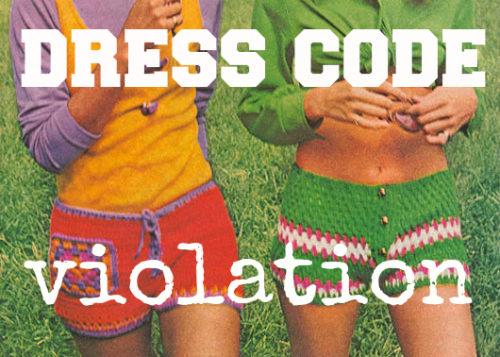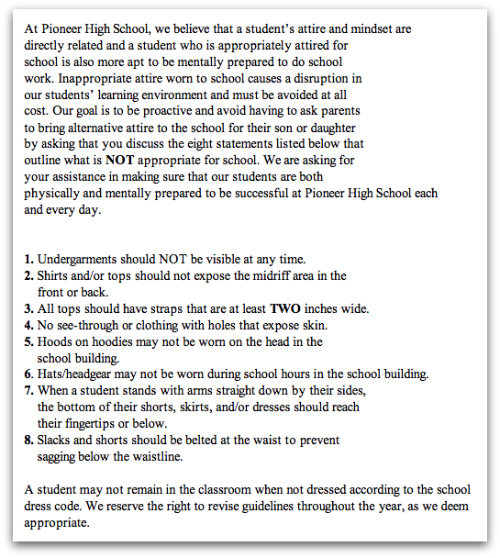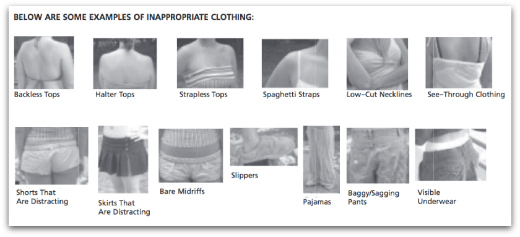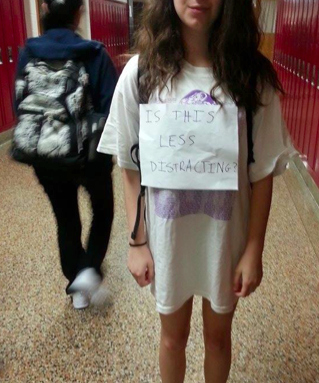
A couple of weeks ago, Ada Banks, a sixteen year old student at Community High, and her friend Julia Hale, a sophomore at Pioneer, drafted a petition aimed at persuading the administrators of Ann Arbor’s public high schools and middle schools to reconsider their dress codes. “As students who must follow these codes,” the two wrote in their petition, “we are speaking out against their discrimination and shaming against girls for what they wear to school.” To date the petition has well over 1,500 signatures, and there are at least preliminary signs that AAPS administrators are taking notice. (Word is that some of their online dress code related material has already been changed.) I reached out to Banks in hopes of finding out more… You’ll find our interview below.
First, though, by way of background, here’s a clip from the Forsythe Middle School handbook which is somewhat representative of the dress codes found elsewhere around the district:
EXPECTATIONS FOR SCHOOL DRESS: Students are expected to dress appropriately for school. Any clothing or accessories that are considered dangerous, disruptive or potentially dangerous or disruptive to the learning environment are prohibited. Students are not allowed to wear chains as jewelry, as a fashion statement, or to hold wallets since there is a possibility that they may inadvertently cause injury or be used inappropriately. Bandanas may not be worn, gang symbols may not be displayed and clothing that depicts alcohol or drugs may not be worn. Hats, coats and backpacks must be left in lockers during the school day. On colder days, sweaters, sweatshirts and fleece tops may be needed for students to be comfortable in all areas of the school. Shorts and skirts for girls should be no shorter than fingertip length. Leggings must be worn with a fingertip length top. Revealing tops, see through tops, sports tops, plunging necklines, bare midriffs, halter or spaghetti strap tops are not permitted. Undergarments should not be visible. For boys, drooping pants are not permitted and underwear should not be visible. Muscle shirts are not permitted. We ask that parents assist their child in making good decisions about appropriate school attire for academic success. Students who dress inappropriately will be asked to change their clothing.
And here’s the relevant passage from the Pioneer High School handbook:

[note: Ann Arbor public schools each administer their own dress code. Community High, as I understand it, does not have a formal policy.]
MARK: So, I hear that you think Ann Arbor public schools should be clothing optional.
ADA: Despite what you might have heard, no one’s trying to go to school naked. We just want to be able to dress ourselves without trying to meet some of the ridiculous rules set by school administrators… Changes need to be made.
MARK: OK, what is it about the current Ann Arbor Public Schools’ dress code standards that you find objectionable?
ADA: Just to clarify, schools within AAPS set their own individual standards, so it’s hard for me to speak for the whole district. The majority of dress code rules are aimed at female students, though, and have hard-line expectations that are almost impossible to meet. Furthermore, these policies often contradict themselves. And, if anything, they promote the sexualization of young girls by treating them as sexual objects from the age of 11 years old.
Sending a teenage girl home for showing cleavage is telling them their body is more important than their education. It’s really just an unnecessary policy, and Community High proves that, in that they don’t have a dress code.
The administration at Slauson justifies their dress code by saying it’s meant to “comfort” students by shielding them from distracting, disturbing and offensive clothing. When I was at Slauson, I was not comforted by having to sit in class wearing jeans in 80-degree weather. Making a girl sit in the office, missing a test, because her clothing doesn’t fit school code is not providing a less distracting learning environment. Having to go and buy different clothes for school is not less disturbing to a student’s education. Having a 13 year old girl bend over in front of her teacher in the hallway, to demonstrate the conformity of her dress, is not providing a more appropriate or less offensive atmosphere for students.
MARK: What, according to the current dress code standards, is an offense that will get someone pulled from class or sent home? What, in other words, are teachers hoping to discover when forcing girls to bend over in front of them? Can you provide specific examples?
ADA: I’ve talked with students from each school, they say girls are usually sent home for shorts. If they don’t go home, they have to sit in the office until their parents can bring them new clothes. Or they have to change into clothes that the administration provides. “It’s considered punishable,” a friend of mine at Pioneer said, “if your shorts don’t reach your fingertips. It doesn’t matter how long your arms are. And tank tops are against the rules. Straps have to be at least three inches wide. And neither you’re back, or your midriff area can be visible at any time. Shorts, though,” she says, “are the biggest thing.”
Here’s a picture from the Huron High dress code, which I find almost shockingly offensive. Of the example photos, two address male students, whereas nine are directed toward girls.

MARK: Do you acknowledge that there’s a need for dress code? In other words, is it just the parameters that you’re objecting to, or is it the fact that a code exists at all?
ADA: I don’t think a dress code is necessary at all, but I do acknowledge that schools are unlikely to abolish them completely. The rules are what really need to be changed. They’re too specific to be applied to everyone. There’s a difference between preventing students from dressing inappropriately and harassing every girl who’s shorts go past her fingertips. Students are capable of dressing themselves in an appropriate way. A 12 year old girl in a tank top should not be treated like a sexual object.
MARK: What kind of response have you gotten thus far to your petition drive?
ADA: We’re currently at 1,614 signatures, with 30+ pages of supportive comments from people all over the country. We’ve gotten support from male and female students of all grades, AAPS graduates, family and friends of students, even one from Australia. People seem to really like it. It kind of affects everyone. Even if it doesn’t make a difference to a specific person, it probably would to one of their friends. The bottom line is it’s just an unnecessary policy that makes the lives of a lot of girls harder.
MARK: You noted that Community High doesn’t have a formal dress code. How do they address dress related issues, and do you think their system could serve as a model for the rest of Ann Arbor’s schools?
ADA: Community has more of an implied dress code, and it works perfectly. It’s true that some clothes are inappropriate for school. At Community if someone wears something inappropriate they’ll either realize it, because they’ll feel uncomfortable, or someone will tell them. Then they just know not to wear it again. We don’t need to be sending girls home for wearing acceptable clothing just because it doesn’t fit a code. Teachers don’t need to be taking time away from their classes to humiliate 12 year old girls by measuring their shorts with rulers. (This happened last year at Slauson.) Community has the highest test scores in the district – no one is distracted because girls are allowed to wear what they want. When you take away the stupid rules, everyone just kind of finds the line for themselves and everyone’s lives become a little bit easier.
MARK: Is there evidence to suggest which system engenders more personal responsibility? In other words, I wonder if the natural consequences that one has to contend with at Community are more likely to result in increased internal regulation and personal responsibility than the alternate top-down enforcement system that we’ve been discussing.
ADA: I’d say Community’s system is definitely more effective than others in preparing students for real life, and that’s kind of the point of school, right? If seeing a girl dressed out of code standards is really that distracting for someone, they need to get over it… In the real world, girls show their shoulders. They definitely shouldn’t be coddled.
MARK: Clearly, as you point out, these current dress code rules seem to target young women, so, at least on the surface, there appears to be a certain degree of sexism. To play Devil’s advocate for a moment, though, isn’t it true that it’s generally young women that are pushing the boundaries of fashion in a high school setting?
ADA: Maybe, but at Community girls aren’t running around in anything scandalous. We dress ourselves, and no one seems offended. Students should be able to wear what they want as long as it’s appropriate, simple as that. Girls aren’t trying to change this policy so they can dress provocatively or get male attention. Here’s a quote from one of the comments on our petition:
We do not wear dresses to distract boys. We do not wear “short” shorts to distract boys. We do not wear tank tops to distract boys. We dress for ourselves, and ourselves only, which is why we are asking for the ability to dress ourselves in the morning. -Kate Vogel, Ann Arbor
If we’re talking about the clothes themselves it’s a much different conversation. You do have a point, and we’re looking at this from two very different perspectives, but, as a teenage girl, I don’t think teenage girls are the problem. It’s true, young women are becoming more and more sexualized and that shows in the way they dress, but to say they’re “pushing the boundaries of fashion” is a stretch. We don’t decide what is and isn’t considered attractive, we don’t control what the stores sell. The only reason we are “pushing boundaries” is because the things we want to wear aren’t actually inappropriate and would be perfectly acceptable anywhere else. It’s unreasonable to tell a girl she has to wear shorts that go halfway down her thighs when there’s nowhere she can buy them. Seriously, go to the mall and try to find store aimed at teenagers that sells shorts with a 3-inch inseam.
MARK: I’m sure the corporations would say that they’re just giving girls the kinds of clothes that they’re demanding. Regardless of the impetus, though, the result is that American girls are becoming sexualized at progressively younger and younger ages. And, you’re right – what we’re seeing play out in school dress codes is a reflection of this disconnect between popular culture and what I guess you could call the traditional American conception of what it means to be a girl. With that said, I’m curious if you’re at all sympathetic to those who see dress codes as a way of pushing back against the hyper sexualization of girls.
ADA: I understand that the codes are directed more towards girls without the intention of discriminating against them, but because they are prone to more revealing dress. Dress codes can be effective in that they generally prevent girls from wearing informal clothing, so I can see why one would think this is desexualizing them. Unfortunately this approach does the opposite. One of the main problems is it starting so early. It teaches girls from a very young age that their bodies are to be viewed in a sexual way. An 11 year old girl does not wear shorts with the intention of being promiscuous. Telling her she can’t wear them because it’s distracting to boys is literally sexualizing her. An 11 year old boy is not so distracted by seeing a girl wear shorts that he loses his ability to focus, and, if he is, that shouldn’t be her problem. By the time these kids even reach the age where this becomes a somewhat relevant problem (adolescence) they’ve already been taught for two or three years that girls are sexual objects and boys are incapable of controlling themselves. This causes huge problems when teens actually start to develop a sexuality. Then the teen boys have been taught they can’t be held accountable for misbehavior if a girl is dressed a certain way. The girls that want male attention think they’re supposed to dress provocatively to be noticed and everyone else thinks they’re supposed to shame them for doing so. This is a dangerous mindset to instill in our children, especially during some of the most developmental years of their lives. These policies are reflective of a society that oppresses women, they sexualize young girls and contribute directly to a culture that blames women for sexual harassment and assault.
MARK: When you say that we should change dress codes because stores in the mall just don’t sell clothes for girls that aren’t, for lack of a better word, “sexy,” it sounds as though you’re just accepting the sexualization of girls. I’m wondering if perhaps, in addition to going after the school system, you might also be inclined to focus some attention on the other side, and call out these companies that are ramping up the sexualization of girls.
ADA: I don’t accept it, but I also don’t oppose women showing skin or dressing “sexy” in the right setting (not at school). By taking that stance I wanted to emphasize that girls aren’t necessarily trying to be promiscuous – they’re wearing what’s in style and it’s considered acceptable everywhere else. What’s considered acceptable is determined by what the stores are selling, what the world’s standards are, etc. Girls can’t be held accountable if what is considered normal doesn’t match school dress code, and they shouldn’t have to go buy different clothes for school. I do feel strongly about the influence corporations (as well as social media and widespread technology) have on the younger generation, and I’d love to make a difference there, but I’m also supposed to be studying for finals right now…
MARK: I know it’s hard to answer, but, in your opinion, do teen girls have better or worse body self-image now than they did a generation previously? Does comfort in wearing these types of clothes, in other words, reflect increased self-respect or lack there of?
ADA: I think it’s really dependent on the person. I think the ability to dress more and more provocatively in public can have both negative and positive effects on a person’s self-respect. It’s really a hard question to answer, especially if you factor in social media, which is new to this generation and has a huge impact on girls’ self-image. I guess I’d say overall it’s probably worsened, but I’d credit that mostly to social media and new technology making it easier and easier to compare oneself to others.
MARK: I guess I can appreciate the arguments on both sides. On one side, it shouldn’t matter at all what a young woman wears to school, right? And it’s offensive that administrators employ arguments about how certain outfits worn by young women are “distracting.” The feminist in me says, “If something’s distracting to the point that boys can’t concentrate, you should be counseling the boys, and not criminalizing the activities of the girls.” It comes very close to the “blame the victim” kind of stuff we often see in rape cases, where people suggest that women were “asking for it” because of the way they were dressed, etc. And that, I think, we all can agree, is reprehensible. On the other side of the coin, though, I’m sympathetic to administrators and their desire to ensure that the environment is one in which education can happen. Regardless of where people fall on that continuum, my hope would be that most folks would acknowledge that there’s a need for open, honest debate on the subject, which includes not just the voices of adults, but also of students.
 ADA: I do see where administration is coming from and what they are trying to accomplish, but It’s really just not working. The fundamental reasoning for a school dress code makes sense, students should be dressed appropriately for school. Students should be able to focus on their work. That makes sense. What doesn’t make sense is how the administration tries to accomplish that. It’s just plain contradictory. How can female students focus on their work when they’re taken out of class for dressing out of code? It’s really hard for me to imagine a scenario where someone’s outfit is so distracting that other students cannot learn. Teenage boys are not lewd mad men incapable of controlling themselves. Teenage girls are not attempting to lure male students away from their studies with tank tops. I don’t know what people are afraid will happen without a dress code. To a certain extent, girls will always distract boys and boys will always distract girls, regardless of dress. [The image to the right shows a female AAPS student’s response to being forced to wear “the shirt of shame” given to young women who come to school wearing tank tops.]
ADA: I do see where administration is coming from and what they are trying to accomplish, but It’s really just not working. The fundamental reasoning for a school dress code makes sense, students should be dressed appropriately for school. Students should be able to focus on their work. That makes sense. What doesn’t make sense is how the administration tries to accomplish that. It’s just plain contradictory. How can female students focus on their work when they’re taken out of class for dressing out of code? It’s really hard for me to imagine a scenario where someone’s outfit is so distracting that other students cannot learn. Teenage boys are not lewd mad men incapable of controlling themselves. Teenage girls are not attempting to lure male students away from their studies with tank tops. I don’t know what people are afraid will happen without a dress code. To a certain extent, girls will always distract boys and boys will always distract girls, regardless of dress. [The image to the right shows a female AAPS student’s response to being forced to wear “the shirt of shame” given to young women who come to school wearing tank tops.]
MARK: Granted, it’s completely different, but it brings to mind recent well publicized cases where kids have been sent home or expelled for bringing nail clippers and aspirin with them into school. Administrators were, no doubt, reacting to something that’s very real in both cases – school violence and drug use – but they’re pursuing enforcement in such a way as to seem almost laughable. Clearly there needs to be flexibility, but you’re dealing with a system where flexibility isn’t encouraged… a system where, perhaps because they’re fearful of lawsuits, they strive for consistency across the board.
ADA: I’m not sure what people are so scared of. There’s already a district-wide standard that says students may not dress in a distracting or inappropriate way, so no one is actually allowed to come to school naked, or in some sort of legitimately distracting apparel, regardless of the school’s specific dress code.
MARK: I’m curious to know your thoughts on boys, and how they fit into this conversation. Has anyone, for instance, asked them how they feel about how young women dress and the pervasive idea that they can’t control their own behavior? Also… and I know it’s likely hard for you to say, as you weren’t around a generation ago… but I wonder how the ready availability of hardcore pornography might have changed this dynamic. Does it make boys more sexually aggressive, or does it perhaps exhaust their interest?
ADA: I think the policy is incredibly condescending to male students. They are not lust-fueled monsters lacking self control around women. I think that as porn is made more and more accessible it has many major effects on society, especially the younger generations. Because it’s staged it really alters some people’s expectations of sex and disconnects them in a way. Other than numbing them to seeing girls with skin exposed, I don’t think it has much of a real effect on dealing with dress codes.
MARK: So, what are the next steps with your campaign? Is there a plan to deliver the petition to administrators, and request specific reforms?
ADA: I’ve been communicating with the AAPS superintendent Jeanice Swift, and she’s been incredibly helpful and supportive. She’s decided to start a Student Advisory group next fall with representatives from each of the high schools, and to make student dress code a priority for work in that group.
Along with that, several other students and I have been collecting stories from students, recording comments from the petition, discussing possible compromises, and raising awareness. Finals are coming up, so we’re all a little stressed, but we’re working as much as we can to get this done, and its moving in a very promising direction.
 Here, in case you’re interested in knowing more about “pay to potty,” is a clip from the article linked to above.
Here, in case you’re interested in knowing more about “pay to potty,” is a clip from the article linked to above.





















